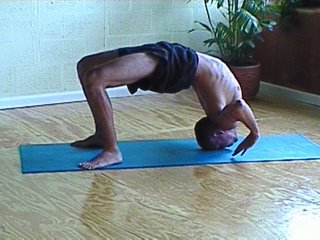Five-Minute Bridge
 Yesterday I read in Yoga Journal that a woman who struggled with anxiety atttacks had a breakthrough while holding a 5-minute bridge pose (setu bandha sarvangasana).
Yesterday I read in Yoga Journal that a woman who struggled with anxiety atttacks had a breakthrough while holding a 5-minute bridge pose (setu bandha sarvangasana).She wrote:
Although I've sought countless therapeutic remedies for my anxiety, the eventual breakthrough I experienced didn't happen on a therapist's couch. It occurred in a single moment in a yoga class, when I managed to get into Setu Bandha Sarvangasana (Bridge Pose)--and stay in it for a full five minutes. Something happened: my back arched, my chest expanded, I breathed more deeply than I would have throught possible. And my mind cleared. All that constant, overwhelming clatter was just gone, blessedly gone.I'm pretty sure I've never had an anxiety attack. But curiosity, I have had. Still do.
I wondered what would happen if I held a five-minute bridge pose. Don't you wonder?
I set my timer and up I went.
 Frankly, it was uneventful, but revealing.
Frankly, it was uneventful, but revealing.I've never held a five-minute bridge pose before, but I have done a 3-minute neck bridge.
I observed experiences and tendencies similar to those I've had while neck bridging.
First I noticed a pretty tremendous stretch in my abdominal muscles. The longer I was in the pose, the stronger this stretch felt.
But the biggest thing that came to my awareness was a tendency to shift weight to the outer edges of my feet. That made my knees come apart, so my thighs were no longer parallel.
I just kept re-adjusting, bringing my knees back toward each other.
The longer I stayed in the pose, the more my buttocks muscles got tired, and eventually, sore.
Soon the timer went off and I gladly came out of the pose.
Holding poses for time reveals weaknesses or tendencies that might otherwise go unobserved.
When you raise your hips off the floor in bridge pose, you're extending the hip joint. (Extension is the opposite of flexion.)
When you extend the hip, the thigh moves toward the back body. Conversely, when you flex the hip, the thigh moves in the direction of the front body.
The gluteus maximus muscle is one of the primary muscles responsible for extending the hip. These are the muscles that began to burn as I stayed longer and longer in the pose.
Gluteus maximus is also responsible for externally rotating the thigh. That's why almost everyone starts to turn the leg so that the knee cap points out away from the mid-line of the body when he or she is working hard to extend the hip.
That's why when you raise your hips away from the floor in bridge pose your knees want to come apart. Gluteus maximus extends the hip and rotates the front thigh out so the knees come apart and weight shifts toward the out edges of the feet.
Keep turning your front thighs in toward each other, even in bridge pose. You'll notice it helps keep the back of the pelvis broad, so you can tuck your tailbone and avoid low back pain in this and other back bendings.
Don't just read about it. Get up. Experience it. Experience yoga!
Kevin Perry
www.ExperienceYoga.org
p.s., The Sanskrit word of the day from my last Daily Yoga Tip was uttana. Uttana means an intense stretch, as in uttanasana, the intense stretch pose.
p.p.s., Today's Sanskrit word of the day is bandha. I'll tell you what it means next time.
p.p.p.s, Don't miss the Experience Sanskrit workshop coming up in Downers Grove, IL on Saturday, April 8. You can register here.
We're also conducting the Experience Neti Flow workshop at Masterpeace Studios in Kirkwood, MO (St. Louis) on May 6 at 3:00 pm. Tuition is $30. You can register here. The Experience Sanskrit workshop is earlier that same day.
p.p.p.p.s., I wrote a Daily Yoga Tip last year about holding poses for time. It's called Timings for a Change. You can read it here.
Copyright 2006.
All rights reserved, Mo Yoga LLC.
Kevin Perry
Mo Yoga LLC
905 Eastland Plaza Suite B, #106
Jefferson City, MO 65101
(573) 680-6737


1 Comments:
Bridge pose is a yoga staple. It is a great concentration improver and yoga guru Leeann Carey says it also a great stretch for the shoulders and chest. She has a free yoga video on bridge pose that I thought your readers might like: http://www.planetyoga.com/free-yoga-video-bridge-pose/
Post a Comment
<< Home